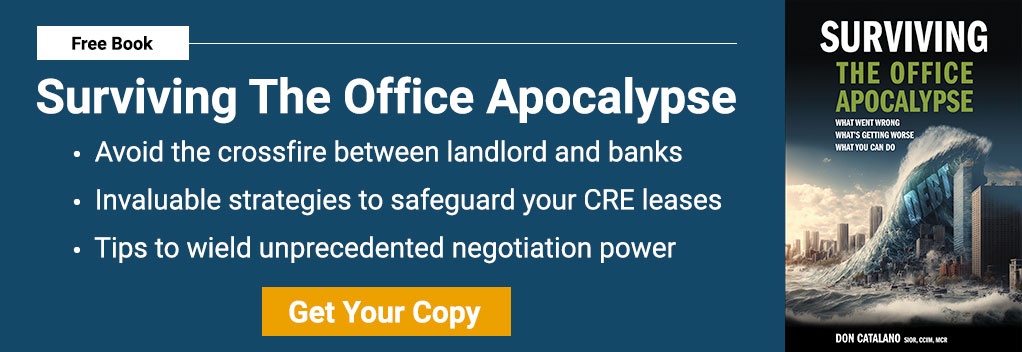The CMBS special servicing rate—a key indicator of loan distress—has jumped for the ninth consecutive month. And if you’re a tenant, CFO, or director of real estate, it’s time to pay attention.
This isn’t just another statistic. It’s a signal that more properties are falling into financial trouble, and that could have serious consequences for tenants across the board.
As special servicing rates rise, so do cap rates—leading to plummeting property values and a flood of distressed assets. Combine this with new, stricter capital requirements for regional banks, and the commercial real estate lending landscape is set to tighten even further.
For landlords already struggling with loan defaults and high vacancy rates, the squeeze is real. And for tenants? It means fewer options, less negotiating power, and the very real risk that your landlord could default, leaving your operations in jeopardy.
Read on, you’ll learn why:
- Rising CMBS rates are a warning—property distress is escalating.
- Higher cap rates are driving down property values, fueling distressed asset sales.
- Stricter bank regulations are tightening lending, leaving tenants with fewer options.
- Act now: Protect your lease and operations from potential landlord defaults.
CMBS Special Servicing Rates: The Canary in the Coal Mine
The CMBS special servicing rate has jumped for the ninth consecutive month, reaching almost 9% averaged across all property types, according to Trepp's latest analysis.
That's a 192-basis point increase over the past year, with office properties leading the pack at 13%—a staggering jump from 8% just a year ago. In total, office properties accounted for a whopping $1.9 billion, or 58% of the total $3.3 billion transferred to special servicing in the latest report.

Special servicing rates are essentially a barometer of loan distress, where properties facing difficulty in meeting debt obligations are flagged for renegotiation or workout solutions. When this rate jumps, it means properties are underperforming, unable to generate the necessary revenue to cover their debt payments. The implications are almost immediate: distressed loans lead to increased cap rates.
For context, special servicing rates by property type:
- Multifamily properties are also feeling the heat, as their special servicing rate broke past 6% for the first time in nearly nine years.
- Retail is nearing a two-year high at 11%, signaling prolonged distress in shopping centers and malls.
- Industrial properties, while relatively stable, have seen their special servicing rate rise to 0.5% from 0.3%, showing that even the traditionally resilient sectors aren’t immune.
Two major loans transferred into special servicing highlight the scale of the problem. The first is a
$525 million loan backed by 150 East 42nd Street in New York City, a 1.7 million square-foot office building where Wells Fargo—the second-largest tenant—is set to leave by 2026.
The other is a $410 million loan from Ashford Hospitality Trust’s hotel portfolio. Together, these loans make up almost $1 billion of the distressed CRE landscape, underscoring the severity of the issue.
Rising Cap Rates and Declining Property Values
Now, in the midst of this storm, Federal regulators are set to impose stricter requirements on mid-sized banks, forcing them to increase capital reserves by an estimated 3% to 4%.
Cap rates are closely tied to the health of commercial properties. As more assets fall into distress, the perceived risk increases. In response, investors demand higher returns to offset that risk, leading to elevated cap rates.

When cap rates rise, property values fall. Investors become less willing to pay premium prices for assets carrying a higher risk, resulting in declining values. This cycle can quickly become self-perpetuating, with rising cap rates driving property values down further, leading to more defaults and higher vacancies, which, in turn, lead to even higher special servicing rates.
And when property values start to go down precipitously, it creates a race to the bottom—where the expectation is that tomorrow will always be the cheaper day to buy. Think of the post-2008 crash and death spiral where some property values dropped up to 50%.
So, back in the context of the office market, as more office buildings lose tenants and default on loans, we could see a flood of distressed asset sales, further driving down property values.
Tougher Bank Rules Squeeze CRE Lending
With regional banks, which account for a large portion of CRE loans, now facing tougher capital requirements, the lending landscape is set to tighten. These regulations stem from lessons learned after the collapse of Silicon Valley Bank, Signature Bank, and First Republic Bank in early 2023.
When interest rates spiked, these banks struggled to cover their losses due to their exposure to low-yield, held-to-maturity (HTM) bonds that had lost value. Now, regulators want to ensure that banks have enough capital to avoid a repeat, even as rates remain high.
For landlords dependent on CRE loans, this is another blow in an already tough environment. This is especially true for those who are already dealing with distressed assets.
|
"There is still a lot of uncertainty. The 10-year Treasury yield has been increasing again, meaning that investors expect higher rates in the longer term. Bank-held CRE loans still face headwinds. -GlobeSt |
For tenants, this creates a dangerous ripple effect: if landlords can’t access capital, they may delay property improvements, fail to honor concessions, or even default on their loans—putting tenant operations at risk.
For the leasing environment, this means that with fewer financing options and tighter budgets, landlords may struggle to maintain properties and/or offer competitive lease terms (with high TI allowances). And for tenants, especially those in office and retail spaces, this could translate to fewer choices and potentially weaker negotiating power.
|
Because when CMBS special servicing rates among offices, have surged to 13%, the strain on landlords is becoming untenable. |
Office cap rates are poised to rise further, especially as the hybrid work model persists and vacancy rates climb. Tenants should prepare for the possibility of landlords either being unable to offer competitive concessions or even defaulting on their loan obligations, which could lead to distressed sales and more property turnover.
Tips for Tenants
In this environment, corporate tenants must take strategic steps to safeguard their interests.
Start by conducting a thorough assessment of your lease agreements, identifying any clauses that could provide leverage in negotiations. Conduct thorough due diligence on your landlord’s financial health and property performance; understanding their stability can inform your negotiations.
And in any new lease agreement, tenants should prioritize negotiating self-help clauses. These provisions empower tenants to take necessary actions—like repairs or maintenance—if landlords fail to meet their obligations, effectively safeguarding business operations.

It's also crucial to include clear terms regarding tenant improvement allowances, ensuring that these funds are accessible and protected, especially in uncertain economic conditions. By proactively addressing these elements in lease negotiations, tenants can fortify their positions and mitigate risks in a volatile commercial real estate market.
Additionally, stay informed about market trends and local economic indicators that could affect your landlord's ability to meet obligations. Being vigilant and proactive can empower you to secure favorable terms and mitigate risks in an uncertain environment.
The Bottom Line: Brace for Impact
Between the escalating special servicing rates and the tighter lending standards, commercial real estate is in a volatile state. Office properties are bearing the brunt of these changes, with the 13% special servicing rate signaling that more defaults could be on the horizon.
At the same time, regional banks—a key source of financing for many landlords—are being forced to hoard capital, limiting their ability to provide loans. For commercial tenants, this creates a precarious environment where landlords are more likely to default, and less likely to make necessary investments in their properties.
As CMBS distress worsens and lending conditions tighten, CFOs, directors of real estate, and tenants need to act decisively. Failing to adapt could leave you at the mercy of a financially unstable landlord or force you to navigate costly relocations. Now is the time to take proactive steps to safeguard your operations and secure favorable terms in a market fraught with risk.
For an essential blueprint to navigate these challenges effectively, don't miss your chance to download Surviving the Office Apocalypse—your guide to thriving in a tumultuous commercial real estate landscape.
Wondering where to begin?
Related Content
- 7 Cities With the Most Distressed Commercial Mortgage-Backed Securities CMBS Loans
- Brookfield Default is $1 Billion of the $1 Trillion in CMBS Loans Due
- Extend and Pretend a Trillion Dollar CMBS Loan Crisis Doesn't Exist
- CMBS Loans Coming Due and Concessions: Trouble in Washington D.C. and Beyond







